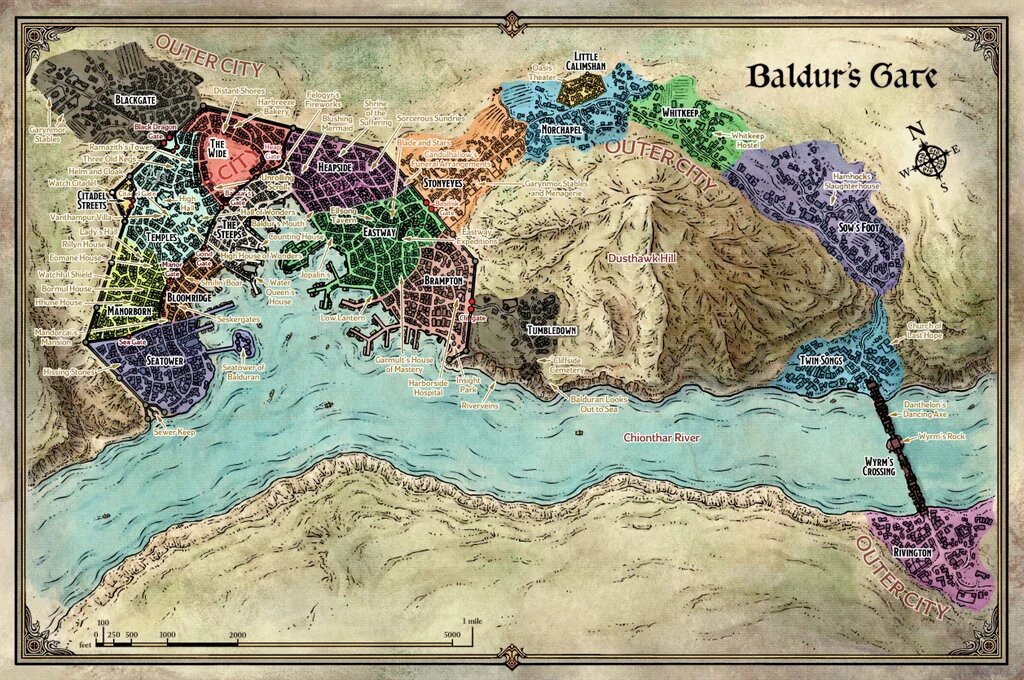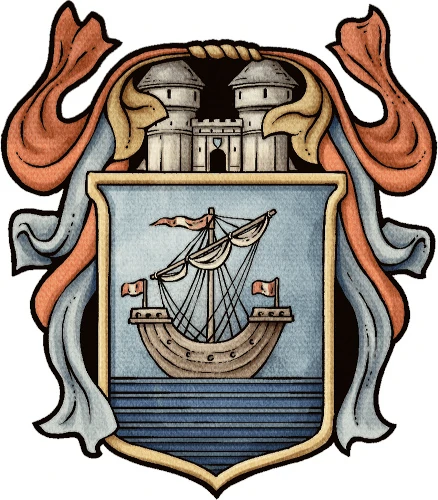Baldur's Gate
Baldur's Gate is one of the largest and well-known cities on the Sword Coast. As a founding member of the Lords' Alliance, Baldur's Gate has often found itself at the center of major events.
History
Early History
Centuries ago, sometime around the 5th-6th century, the site that would become Baldur's Gate was simply known as Gray Harbor. One day, the ancient hero Balduran returned to Grey Harbor filled with riches and wealth. These fortunes greatly increased Gray Harbor's standing and in honor of their new patron, one of the new wall passages in the city was named Baldur's Gate. Within a generation, this gate became synonymous with the community, and the settlement known as Baldur's Gate began appearing on maps of the Sword Coast. Shortly after this, tensions began growing between the rich farmers and patriars that lived in the Upper City and the sea captains around the port. The farmers demanded exorbitant fees for the captains and tradesman to enter the city through Baldur's Gate, which the captains refused as it was one of their own, Baldurian, that built the gate. Tensions rose and one day the captains stormed the walled city, capturing it, burning houses, and tearing the city apart. Four of the strongest captains declared themselves the new leaders of Baldur's Gate. These captains created the Council of Four, mockingly calling themselves "Dukes," and the the title stuck. This reign of sea captains would not last, as the new leaders of the city grew rich and began resembling the rich farmers and patriars they replaced. Before long, the Upper City once again lorded over the Lower City. In 1332, future Grand Duke Eltan arrived home in Baldur's Gate and was appalled by the horrid state of affairs in the Lower City. Eltan used his funds from adventuring to create the Flaming Fist mercenary company, which quickly acquired a contract to police the Lower City, a role it still serves to this day.
Modern History
In the early 1400's, Grand Duke Valakarn attempted to seize power in the city for himself, but was stopped following intervention from the Flaming Fist, the Watch, and the patriars of the Upper City. Worried something like that could happen again, the Council of Four was dissolved and replaced with the Parliament of Peers. However, the newly formed parliament was incapable of acting as an effective executive force, and the Council of Four was shortly brought back, with the Parliament of Peers acting as a legislative body. From the 1430's -1482, Baldur's Gate entered a a golden age. The city was ruled by Grand Duke Abdel Adrian, a beloved ruler and one blessed with an extended lifespan due to his nature as a child of the god Bhaal. Despite this, Adrian was able to resist innate calls for evil, and used his power and lifespan to serve his city faithfully. In 1457, the feared pirate Kelton Hunter attacked Baldur's Gate's harbor aboard his ship the Poisoned Poseidon. Adventurers and the Flaming Fist were able to force Hunter's ship aground in Brampton, where Hunter's crew was killed and the captain disappeared, while the rest of his fleet was driven off. In 1482, a hidden child of Bhaal attacked Grand Duke Adrian and in their scuffle one of the transformed into the Bhaalspawn, an Avatar of Bhaal. The Bhaalspawn rampaged in the the Lower City before it was brought down by a ragtag group of adventurers, led by Jessabelle Leonin, and the Flaming Fist organized under Ulder Ravengard. This tragic event became known as the Bhaalspawn Crisis and was etched into the memories of every Baldurian that was alive that day. Following Grand Duke Adrian's death, Ulder Ravengard was made Grand Duke. Breaking tradition, Ravengard did not relinquish his position as head of the Flaming Fist upon being made Grand Duke, making him the most powerful Grand Duke Baldur's Gate had had in centuries. Under Ravengard, Baldur's Gate began expanding overseas, using Flaming Fist resources to establish pseudo colonies in far off lands, such as Chult, and positioning itself to be a major economic power. In 1491, Baldur's Gate again erupted into chaos during the Baldur's Gate Uprising, violently dragging the city into the Great Dragon War. Alexander Rake, a councilman on the Parliament of Peers, aligned himself with the Cult of the Dragon to seize power in Baldur's Gate and preemptively stop Baldur's Gate from interfering in the cult's plan to summon Tiamat to the Prime Material Plane. However, the cult's plan was stopped by the Breadwinners, an adventuring party attempting to unite the Lords' Alliance against the cult. The uprising crushed, Baldur's Gate pledged itself to join the Council of Waterdeep. As a part of the Council of Waterdeep, Ulder Ravengard represented Baldur's Gate and pledged to their cause the forces of the Flaming Fist. Baldur's Gate's forces saw action in both the Battle of Hardbuckler and the Battle at the Well of Dragons.Geography
Baldur's Gate is divided into three distinct districts.
The Upper City is the home of the patriars and the elite of the city. Kept safe by the forces of the Watch, the district is beautiful, opulent, and always mired in politics.
The Lower City is the large, crescent-shaped portion of Baldur's Gate fully contained within the walls. It features tightly-packed streets, lined with tall and slender buildings and even narrower alleyways that are always busy with the comings and goings of city life. Trade, commerce and work of all sorts dominate the sprawling district. This district is under the protection of the Flaming Fist, though their "protection" often resembles that of an occupying army more than a police force.
The Outer City is a sprawling, chaotic shantytown that grew outside of the city's walls. Day and night blend together throughout the lean-to's, stockyards, and other shacks that line the Outer City's muddy streets. While the animal-handlers, merchant-hawkers and other "outsiders" are taxed and technically "ruled" over by the Grand Dukes, city officials do little to truly govern the unregulated Outer City.
Founding Date
Around 300 DR
Alternative Name(s)
The Gate; Gray Harbor
Type
Large city
Population
125,000
Inhabitant Demonym
Baldurian
Location under
Included Locations
Owner/Ruler
Owning Organization
Characters in Location






Comments